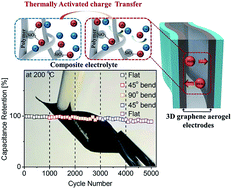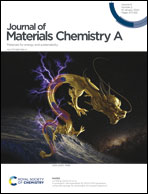A super-thermostable, flexible supercapacitor for ultralight and high performance devices†
Abstract
The design and optimization of new composite electrolytes and nanostructured carbon electrodes constituting electrochemical energy storage devices such as supercapacitors are definitely important because of the increasing challenges of providing reliable electrical energy in harsh environments. Here, we develop super-thermostable, flexible, and high-performance supercapacitors operating at high temperatures and under mechanical stresses. The multifunctional supercapacitors are fabricated by integrating an ionic liquid-fumed silica nanoparticle composite polymer electrolyte and 3D graphene aerogel electrodes with controlled hybrid porous structures. The thermal and electrochemical stability of the composite polymer electrolyte and excellent compatibility between the electrolyte and the porous aerogel electrodes lead to high-performance supercapacitors with an extremely high specific capacitance of 1007 F g−1 and an energy density of 1134 W h kg−1 at a high temperature of 200 °C. In a flexibility test in dynamic mode, the device exhibits extreme long-term stability and mechanical durability after bending cycles even at high temperatures. This research provides a rational strategy for light weight, mechanically robust, high-performance, and high-temperature operation energy storage systems operating under harsh circumstances.



 Please wait while we load your content...
Please wait while we load your content...